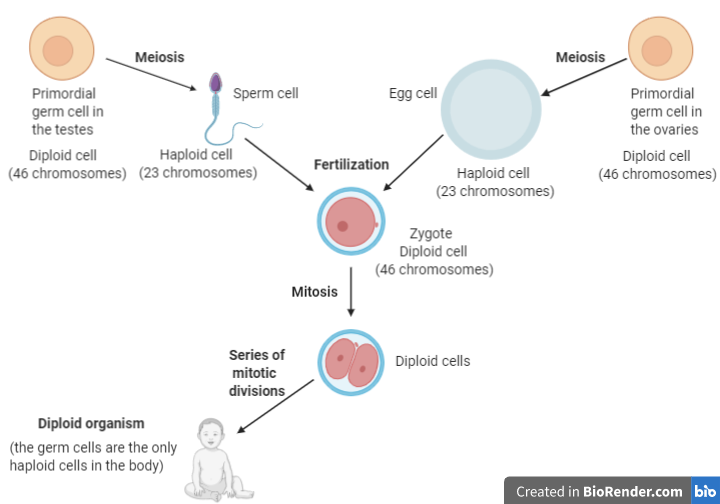Have you ever wondered how the organs of an embryo develop inside the womb, how the immune system heals infections, or how a tree becomes taller with time? All of the organisms survive, grow, and reproduce by creating new cells. But how do new cells occur? No matter the organism or the type of cells, in the case of multicellular organisms, new cells are formed from pre-existing cells. That means they cannot develop from scratch. A cell must already exist to give rise to new cells through cell division. Now let’s take a look at the life of a cell.
Cell cycle
From the moment a cell is formed by its parent cell until it gives rise to daughter cells of its own, it goes through the cell cycle, meaning the life cycle of the cell. The cell cycle consists of two phases, interphase during which the cell grows, and mitosis that results in cell division. Interphase is divided into three stages, called G1, S, and G2. What does it mean that the cell grows during interphase? It means that it grows in size, it synthesizes RNA and proteins, replicates its DNA, goes through normal processes of metabolism, and prepares for division. The G in G1 and G2 comes from the term Gap phase because the cell seems to be resting between cell divisions. S, on the other hand, comes from the word Synthesis since, during the S phase, the cell replicates its DNA.
From interphase to mitosis
G1 phase: RNA and proteins are produced, the cell grows in size and ensures that everything is safe and ready for the cell to prepare for the division.
S phase: DNA is replicated to create two identical sets of chromosomes, each one intended for each of the two daughter cells that will appear at the end of the cell cycle.
G2 phase: Proteins are produced again, and the cell grows more in size. It determines whether it is safe to proceed to the M phase and undergo cell division. Condensation of the genetic material also occurs, so that it can be separated into the two daughter cells.
M phase: It is a short phase compared to interphase. The two sets of chromosomes are divided, one ends up to one pole of the cell and the other one to the opposite pole. In addition to that, the cytoplasm divides in a process called cytokinesis. At the end of this phase, the cell divides into two daughter cells, each one with a complete set of chromosomes. These are identical to each other and to their parent cell as well.

Somatic cells vs Gametes
We focused on the steps of the cell cycle that result in the mitotic phase, for the production of two identical daughter cells. However, mitosis is not the only type of cell division, and therefore, not all cells undergo this process. The other type of cell division is called meiosis, and it does not occur in somatic cells. At this point, we need to distinguish the two different types of cells that are present in each eukaryotic organism that goes through the process of sexual reproduction. These are somatic cells and gametes.
Somatic cells are all of the cells of an organism except sperm and egg cells. Somatic cells are diploid, meaning that they contain two sets of chromosomes, one from the mother and one from the father. A few examples of somatic cells are neurons in our brain, epithelial cells in our intestines, or blood cells in our circulation. On the other hand, gametes or sex cells are the cells that unite to give rise to the offspring. These are egg cells in females and sperm cells in males, and they are produced in certain regions in our reproductive organs. Gametes are haploid cells, meaning that they contain only one set of chromosomes.
Mitosis vs Meiosis
When a sperm cell fertilizes an egg, it results in the formation of the zygote, the first cell of the new organism. Billions of cells will be produced from this single cell through consecutive mitotic divisions and will slowly form an organism, similar to its parents. However, all of the somatic cells, and consequently, the zygote of this new offspring must be diploid cells and carry one copy of each chromosome from the mother and one from the father. That is why the egg and the sperm are haploid cells containing half the chromosomes of the zygote.
Let’s use humans as an example. Diploid human cells carry 46 chromosomes, while gametes only 23 chromosomes because they are haploid cells. Consequently, the zygote acquires two sets of 23 chromosomes and becomes a diploid cell with 46 chromosomes as well.
How do the gametes get rid of the second set of chromosomes? These are formed during meiosis, another type of cell division, as we mentioned before. Their parent cells, which are called primordial germ cells, undergo DNA replication and two consecutive mitotic divisions that reduce the number of chromosomes in half. These two mitotic divisions make up meiosis. Therefore, the cell cycle remains the same up until it is time for the cells to divide. Since there are now two divisions, instead of one, four daughter cells are formed, but they are not genetically identical to each other, or their parent cell.

Conclusion
Mitosis: A process of cell division that occurs in somatic cells and results in diploid cells that are genetically identical to their parent cell.
Meiosis: A type of cell division that gives rise to haploid cells called gametes. These contain half of the chromosomes of the parent cell.
A more detailed description of each type of cell division is coming on the next articles.
